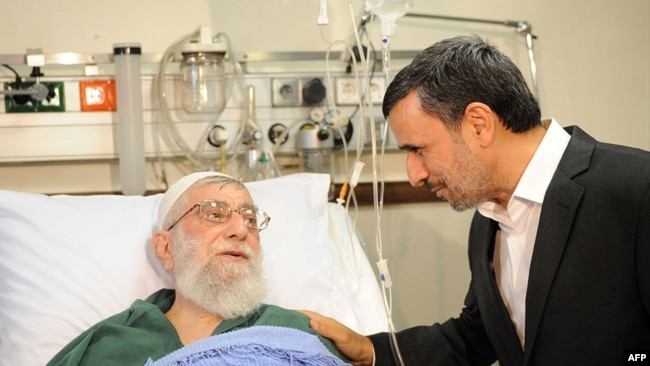Radiofarda – Among the cacophony of voices calling for change in Iran, one stands out for being wholly unexpected—that of hardline former President Mahmoud Ahmadinejad.
Once Supreme Leader Ayatollah Ali Khamenei’s favorite, Ahmadinejad has become outspoken in his criticism of the regime, especially its oppression of freedom, and his supporters have grown in number and evolved from a motley mix of conservatives who disagree with Khamenei to a serious political force.
Ahmadinejad began clashing with the Supreme Leader during his second term in office from 2009-2013. Khamenei rejected Ahmadinejad’s appointment of his close relative and populist figure Esfandiar Rahim Mashai as his vice-president.
In May 2011, Ahmadinejad fired his Intelligence Minister Heidar Moslehi, but again Khamenei over ruled his decision. Moslehi was re-instated and Ahmadinejad refused to go to work for eleven days, to no avail.
In February 2012, Ahmadinejad hijacked a session of Iranian parliament on live TV by screening a video showing parliament Speaker Ali Larijani, Chief Justice Ayatollah Sadeq Amoli, and Larijani’s brother Fazel demanding a bribe from two other officials, bringing disgrace to regime insiders.
In May 2013, Ahmadinejad defied Khamenei’s advice and nominated himself as a candidate to run for president. The Guardian Council disqualified him.
In the winter of 2018, as the judiciary clamped down on his allegedly corrupt aides, Ahmadinejad wrote several letters to Khamenei and gave speeches criticizing the way Khamenei ruled the country, questioning the regime’s integrity, and attacking the judiciary with an especially harsh tone.
It was at this stage that Ahmadinejad and his aides started sit-ins at shrines and mosques in various parts of Tehran during which they openly criticized state officials, including the heads of the legislative, judiciary, and executive branches, and finally Khamenei himself for failing to control those three institutions.
In one letter, Ahmadinejad called on Khamenei to fire the heads of the three branches and to introduce fundamental changes everywhere, including in his own office.
When the courts jailed two of his closest aides, Mashai and Hamid Reza Baqai, Ahmadinejad attempted to mobilize others against the system. It was then that he encouraged 300 of his supporters to echo his attacks on state officials and his criticism of the system by co-signing a letter to Khamenei.
The number of signatories of this letter later reached as many as 800. All of the signatories are known to be part of Iran’s diverse conservative camp, mainly those who worked with the Ahmadinejad administration between 2005 and 2013.
Ahmadinejad’s supporters before the publication of this letter were mostly disorganized and without any political background. After this initial letter, the group’s criticism of the regime spread to engulf not just the three branches of government, but also other institutions such as Guardian Council, state TV, The Islamic Revolutionary Guards Corps, and Friday prayer leaders.
His wide circle of supporters now includes members of the Basij (an IRGC affiliated paramilitary force), and university students and lecturers.
They warned Khamenei in the letter that his “regime is becoming increasingly lifeless and fragile and needs fundamental reforms.” They expressed concern over the “unsatisfactory situation of justice, freedom, democracy and independence in the country.”
The importance of the letter is that those who signed it, until recently sympathized with the regime, but are now using the same language as the opposition.
Although they are still not influential players in Iranian politics, they appear to be establishing themselves as a sizeable force that could put its mark on future developments at the right time.
 Shabtabnews In this dark night, I have lost my way – Arise from a corner, oh you the star of guidance.
Shabtabnews In this dark night, I have lost my way – Arise from a corner, oh you the star of guidance.




